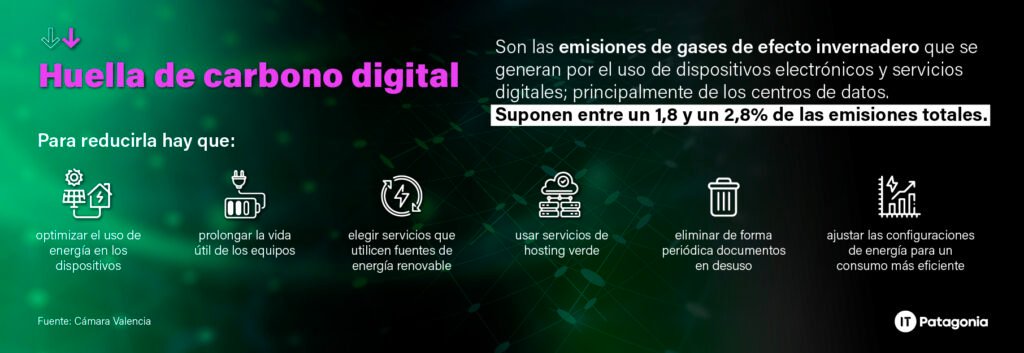Carbon footprint: how the IT industry can help reduce it
Focusing on reducing the carbon footprint is crucial to mitigate climate change, since greenhouse gas emissions are the main cause of global warming.
Reducing the carbon footprint is vital to help reduce adverse effects on the environment, such as rising temperatures, melting glaciers, and extreme weather events.
As part of the process, choose Technology providers committed to sustainable practices It is an excellent idea to help restrict the direct environmental impact.
In this article we analyze What the carbon footprint consists of and how it is generated, how it is calculated and measured, and its impact on the environment.
In particular, we will address the effects of the digital carbon footprint, How the IT industry can mitigate it and what are the main challenges companies face in achieving this.
What is the carbon footprint?
The carbon footprint is a measure of the Total amount of greenhouse gases (GHG) emitted directly or indirectly by an activity, product, organization or individual, over a given period of time.
The footprint is usually expressed in tonnes of carbon dioxide equivalent (CO2e), which is a unit that combines the emissions of different greenhouse gases in terms of their climate impact equivalent to carbon dioxide.
In the technological field, the digital carbon footprint refers to the greenhouse gas emissions generated by the use of electronic devices and digital services.
Includes the energy consumed in the manufacture and use of computers, mobile phones, and other devices.
Also the operation of data centers and data transmission through telecommunications networks.
Every time you carry out activities related to data management, internet searches or simply sending emails, there is an impact on your digital carbon footprint, based on the energy required by servers and network infrastructure.
To reduce the digital carbon footprint, it is important to:
- optimize the use of devices,
- extend the life of the equipment,
- choose services that use renewable energy sources and
- adjust power settings for more efficient consumption.
Current affairs: What is the impact of the digital carbon footprint?
To understand the importance of the digital carbon footprint and why we must begin to look for measures to slow it down and reduce it, it is essential to know some data.
From the Valencia Chamber they report that the Digital carbon footprint emissions already account for between 1.8 and 2.8% of total emissions, and In 10 years it could equal that generated by transport.
In this regard, they point out that the digital carbon footprint is mainly a consequence of the activity carried out by data centers.
And that global electricity consumption generated by Internet use is similar to the electricity consumption of a single country.
Meanwhile, an article by United Press International Inc. referenced by Computer Weekly warned that the Global computing is responsible for between 2.1 % and 3.9 % of global greenhouse gas emissions.
To put this into perspective, they point out that the aviation industry generates 21%3T of these emissions.
According to the Argentine Network of the Global Compact, in Argentina, 41% of companies claims to carry out actions that allow measuring and sizing the impact of their activity on the environment.
How is the carbon footprint generated?
The carbon footprint is generated mainly through the emission of greenhouse gases (GHG) such as carbon dioxide (CO2), methane (CH4) and nitrous oxide (N2O), from various human activities and industrial processes.
Among the main factors involved in the generation of the carbon footprint, which may vary depending on the context and the specific activity, are: consumption of energy generated by fossil fuels, the burning of fuel by transport, and the industrial processes.
Agriculture is also a major source of greenhouse gas emissions., due to the production of methane by animals such as cows and nitrous oxide used in soil fertilization.
Something similar happens with the deforestation and forest conversion and other ecosystems on agricultural, urban or industrial lands.
In addition, inadequate waste management contributes to increased methane and CO2 emissions.
For its part, the generation of the digital carbon footprint is mainly influenced by the manufacturing and use of electronic devices, the operation of data centers and their transmission.
In particular, data centers, which store and process large volumes of information, require enormous amounts of electricity to operate and stay cool.
In addition, data transmission via telecommunications and Wi-Fi networks contributes to global energy consumption, expanding the digital carbon footprint.
All of these factors interact in complex ways and can vary by region, industry, and individual lifestyle.

How does the digital carbon footprint affect the environment?
As we mentioned before, the digital carbon footprint expresses the greenhouse gas (GHG) emissions associated with the use of digital technologies.
These emissions are generated mainly during the production, operation and disposal of digital equipment and services, as well as during the generation of energy needed to power them.
The impact of the digital carbon footprint on the environment can be observed in the following variables:
- The operation of electronic devices and digital technology infrastructure requires large amounts of energy, which is often generated from fossil fuels, contributing to greenhouse gas emissions and climate change.
- The manufacturing of electronic devices and components, such as chips and displays, involves energy- and material-intensive industrial processes, with emissions associated with raw material extraction, product manufacturing and transportation.
- Improper disposal of obsolete or unused electronic equipment can release toxic substances and pollutants into the environment, resulting in the loss of valuable resources.
- The continued growth of digital infrastructure, including data centers and communication networks, requires significant expansion of storage and processing capacity, increasing energy consumption and GHG emissions.
Why is it important to reduce the digital carbon footprint?
Reducing the digital carbon footprint is necessary for mitigate climate change, conserve finite natural resources and reduce pressure on sensitive ecosystems.
Also, to protect human health and prevent diseases related to environmental pollution.
To achieve this, it is important to promote the adoption of practices and the incorporation of sustainable technologies in the digital field, to achieve a a more equitable and environmentally friendly development model.
Among other actions:
- Adopt a conscious and sustainable approach towards technology.
- Optimize the use of electronic devices to extend their useful life.
- Choose more energy-efficient equipment.
- Choose providers that use renewable energy to operate their data centers and minimize energy consumption.

How is the carbon footprint calculated and measured?
Carbon footprint calculation can vary in complexity depending on the scope and accuracy desired, but generally involves the following steps:
1. Determine the activities or processes that generate greenhouse gas emissions.
2. Collect information on resource consumption and energy used in the identified activities.
3. Use standard or region-specific emission factors to convert consumption data into greenhouse gas emissions. This provides an estimate of the amount of greenhouse gases emitted per unit of consumption of a specific resource.
4. Convert emissions of other greenhouse gases (such as methane and nitrous oxide) to their carbon dioxide equivalent using appropriate conversion factors.
5. Analyze the results of the carbon footprint calculation and generate a report detailing the main sources of emissions and reduction opportunities.
As for the carbon footprint calculation methods, some of the most common are the following:
- Greenhouse Gas Protocol (GHG Protocol): widely used international standard that provides detailed guidelines for measuring and reporting greenhouse gas emissions from organizations, products and projects.
- Life Cycle Analysis (LCA): a more comprehensive approach, which analyses greenhouse gas emissions throughout the entire life cycle of a product, from the extraction of raw materials to disposal.
- Industry standards:Some specific industries and sectors may have carbon footprint calculation methods tailored to their particular needs and characteristics.
How can the IT industry reduce the global carbon footprint?
The technology industry can play a significant role in reducing the global carbon footprint by implementing sustainable practices and technologies in its operations and products.
In relation to data centers, energy efficiency must be improved through the server consolidation, the use of efficient hardware, the cooling optimization and the use of renewable energies.
From a software perspective, developing and using more efficient and optimized systems. At the hardware level, Develop sustainable products with a longer life cycle, from design and manufacturing to disposal.
In terms of supply chain management, promote sustainable practices such as the selection of responsible suppliers, and the reduction of emissions in the production and distribution of components and equipment.
Main challenges for companies to reduce their carbon footprint
Companies face several challenges in relation to reducing their carbon footprint and mitigating climate change.
These include:
- Shifting their business models towards more sustainable and environmentally friendly options. This requires revising production processes, implementing cleaner and more efficient technologies, and incorporating responsible business practices.
- Comply with increasingly stringent environmental standards and regulations imposed by governments and regulatory authorities. This is achieved by using energy efficiency standards, reducing polluting emissions and developing sustainability reports.
- Collaborate with suppliers to reduce emissions throughout the value chain by making adjustments to production, transportation and logistics processes.
- Educate and engage employees in reducing their carbon footprint.
IT Patagonia: commitment to reducing the carbon footprint
One of the reasons that prompted us to go through the certification process as a B Company is the possibility of being part of a global movement committed to an economic system that benefits the planet and all people.
B certification is a continuous improvement tool, which allows us permanently increase our positive impact.
At IT Patagonia we consider ourselves an agent of transformation and we believe that It is time to regenerate the system and be part of a new way of doing business.
As a certified B Company and in the face of the current climate crisis, we are committed to an environmental agenda that sets impact reduction goals for 2030 and 2040.
And that is why we act every day focused on solving the problems of the climate crisis.
Our environmental policy is expressed in the measurement of carbon footprint, efficient energy consumption and comprehensive waste management.
Since 2021, we have been measuring our carbon footprint to understand the impact of our activities and find ways to offset it.
Also, in the training and awareness of interest groups, the mitigation strategy and the compensation of environmental impact. In addition, we choose suppliers who share our same vision.
Being a B Corp means meeting the highest standards of verified social and environmental performance, public transparency and legal accountability, to balance profit and purpose.
We invite you to discover how we do it.

